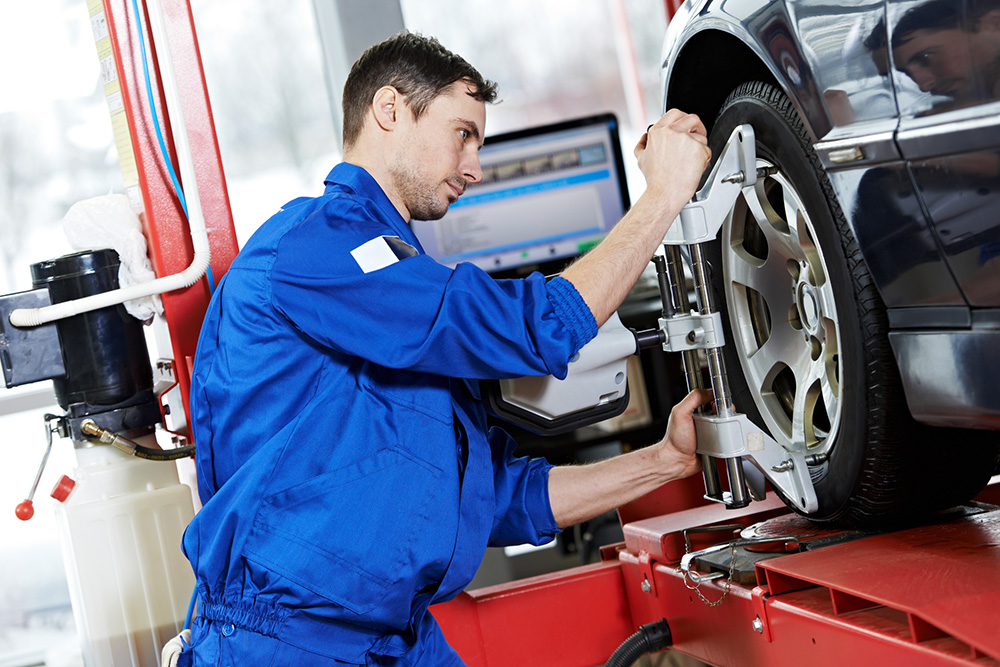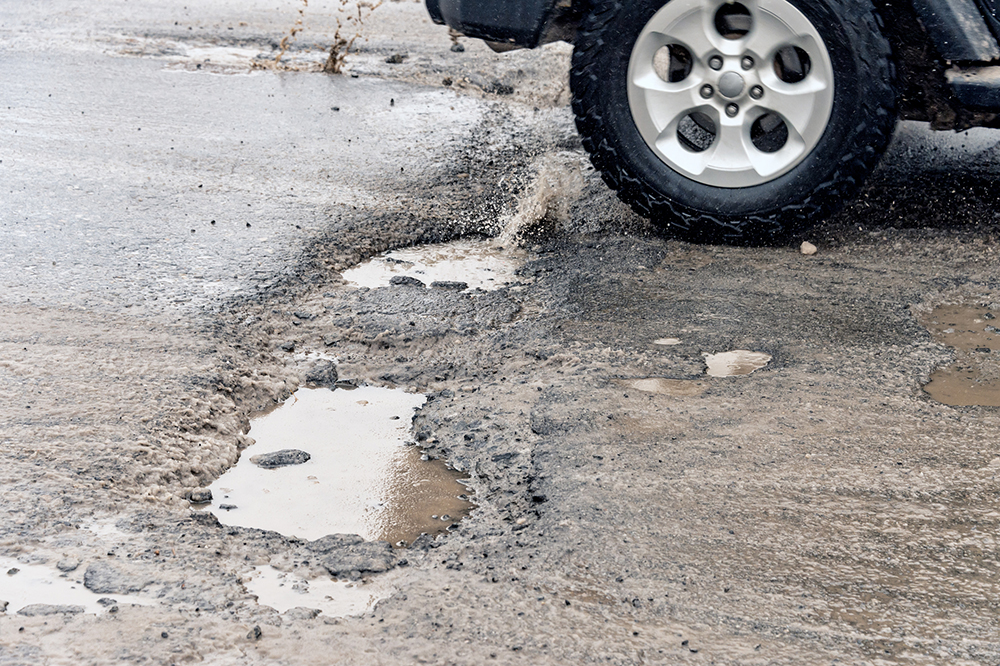Alignment
Wheel Alignment in Houston, Texas
 Proper wheel alignment is a critical safety service for all of your driving in Houston Heights as well as Woodland Heights, Shady Acres and Lazybrook/Timbergrove areas. Alignment services should be considered a part of routine vehicle maintenance, impacting not only performance and cost of ownership but also playing a pivotal role in ensuring the safety of both the vehicle and its occupants.
Proper wheel alignment is a critical safety service for all of your driving in Houston Heights as well as Woodland Heights, Shady Acres and Lazybrook/Timbergrove areas. Alignment services should be considered a part of routine vehicle maintenance, impacting not only performance and cost of ownership but also playing a pivotal role in ensuring the safety of both the vehicle and its occupants.
Alignment issues can arise from normal everyday driving throughout Harris County. Taking care of your vehicle’s wheel alignment helps you navigate the North Loop Freeway, Interstate 45 and the Katy Freeway.
All vehicles encounter issues that knock alignment out of whack such as being in an accident, driving over a pothole or even running into a curb. Even an accumulation of normal everyday obstacles like speed bumps, little potholes or bumpy roads over a period of time will take its toll.
Proper wheel alignment from Quick Lane at Tommie Vaughn Ford contributes to prolonged tire life, improved fuel economy, and enhanced driving experience while providing a paramount aspect of safety.
What is an Alignment?
Also known as tire or wheel alignment, this procedure involves adjusting the wheels so that they are perpendicular to the ground and parallel to each other.
Technicians take readings for each wheel using sensors to determine the angle they impact the road surface. They begin the alignment process by driving your vehicle onto an alignment lift and fitting sensors onto each tire. The sensors are then measured by a computer to determine three angels of the tire–toe, caster and camber.
The toe angle is the most common adjustment made to vehicles and is calibrated with the steering wheel pointed straight ahead. It determines the tilt of the wheel inward or outward from the front to back when viewed from above.
That is, does your tire point in a straight line from front to back? Or does it look like your wheels are turned left or right when viewing from the top?
The measurements are determined with the steering wheel pointing straight ahead.
The caster is viewed from the side and measures the forward or backward tilt of the steering axis. The ideal caster angle is slightly forward of the center axis, also known as positive caster. Negative caster is when the angle is towards the rear of the center axis.
The camber is the inward or outward tilt of the wheels from the top to bottom relative to the road surface. The ideal camber reading for most vehicles should be close to zero, indicating a vertical orientation or 90 degree angle relative to the road surface. Most cars are within one degree of vertical and usually a negative camber, tilted inward, to improve handling.
Difference between an alignment and balancing tires
Tire balance and alignment should not be confused–the two are distinctly different procedures, both are important for tire longevity, handling and braking.
Tire balancing makes sure that the weight is equally distributed around the entire wheel. Signs of a tire being out of balance are a vibrating steering wheel, floorboard and/or seat when in motion without the brakes being applied.
Tire balancing usually is recommended every 5,000 to 6,000 miles and can help extend the lifespan and performance of the tire. Check your vehicle owner’s manual for manufacturer’s recommendations.
Do I need an alignment? I just got a tire rotation
Alignment does not replace the need for regular tire rotation. Instead, it complements rotating tires.
Also, rotating tires without checking alignment could cause steering, braking and tire wear issues. The tire rotation service moves them to different locations or positions on the vehicle.
Your vehicle is designed to have a different weight from front to back. In most vehicles, the heavier weight of the engine and drivetrain cause the front tires to wear faster than the rear tires.
Not performing regular tire rotations can lead to uneven tire wear, shorten tire life and lead to buying a new set of tires earlier than anticipated. General guidelines recommend that you rotate your tires every 6000-8000 miles usually in conjunction with an oil change.
Quick Lane includes a tire rotation in The Works® Oil Change package.
What are signs that you need an alignment?
- The car is pulling to one side of the road
- The tire treads are wearing out prematurely or unevenly
- The tires are squealing
- The steering wheel is off-center when you're driving in a straight line
- The steering wheel vibrates when accelerating
Is it safe to drive a vehicle out of proper alignment?
Proper wheel alignment is synonymous with stability and control on the road. Aligned wheels provide a vehicle with optimal handling, minimizing the risk of skidding or loss of control, especially in challenging driving conditions.
Misaligned wheels can contribute to hydroplaning during wet conditions, posing a serious safety concern. A stable vehicle is a safer vehicle, helping to reduce the likelihood of accidents.
Through proper alignment, the tires maintain consistent contact with the road, enhancing overall safety, particularly in adverse weather conditions. Aligned wheels play a crucial role in emergency handling, allowing drivers to respond promptly and safely to sudden obstacles or the need for quick maneuvers.
Aligned wheels optimize braking efficiency by ensuring uniform brake pad contact. This not only enhances braking performance but also reduces the risk of accidents, especially in emergency braking situations where reliable stopping power is essential for safety.
A vehicle with proper alignment provides drivers with the confidence to navigate unexpected situations, contributing to overall road safety.
When should an alignment be done?
-
When replacing new tires. Get the most value out of your new set of tires by checking alignment before you drive out of the Greater Heights or North Houston areas. Your tire purchase is an investment in safety. Assure you get the most out of your investment by extending the tread life of your tires, increasing gas mileage and improving vehicle handling.

-
If you raise or lower your vehicle. Changing the height of your vehicle changes the toe, camber and caster angles. check alignment whenever you replace any of your suspension or steering components.
-
Replace or adjust suspension components. New shocks or struts can change the angels of the tires and wheels as well. A different brand of shock or strut might have a different ride height then the previous brand and therefore a different angle on the tire.
-
Involved in an accident or hard impact with a curb, pothole or debris on the road. Any hard impact can knock your vehicle out of alignment. If your shocks, struts, ball joints, tie rods, bushing or control arms are damaged, chances are your alignment no longer meets factory specs. Look for telltale signs your vehicle may need an alignment–uneven tire wear, vehicle pulling to one side and other common indicators. Or drive over to Quick Lane at Tommie Vaughn Ford and we can check your alignment for you.
-
You notice uneven steering wheel or tire wear. Uneven tire wear shows up as more tread on the inside of the tire then the outside or vice versa. Uneven tire wear can cause your vehicle pulls to one side or require you to adjust the steering wheel slightly to one side or the other so the vehicle rolls straight. The problem also is known as an “uneven steering wheel.” If you notice these symptoms, bring your vehicle into Quick Lane for an alignment inspection before the issues cause permanent damage to your vehicle tires, steering or suspension components.
-
How often should I get an alignment? You should have your alignment checked at least once a year or around 6,000 to 8,000 miles. You only need an alignment if your toe, caster or camber angles are out of specifications.
-
What are the benefits of an alignment? Alignment inspection and adjustments are important preventative maintenance for the safety of you and your family.
Here are some of the main reasons to consider getting an alignment inspection after every oil change service and every time you purchase a new set of tires:
- Prevents uneven tire wear through regular wheel alignments not only extends tire life but also contributes to safer driving.
- Ensures consistent traction to help reduce the likelihood of tire blowouts and failures–two critical safety concerns, especially when traveling in remote areas..
- Reduces stress on the suspension components, contributing to the integrity of the suspension system. This, in turn, minimizes the risk of sudden failures that could compromise safety, providing an additional layer of protection for both the vehicle and its occupants.
- Saves money by extending tire life, improving fuel economy, and enhancing vehicle handling through regular alignments.
- Delivers a secure and reliable driving environment for your next journey. Proper tire alignment is an investment in the safety of you and your family.

